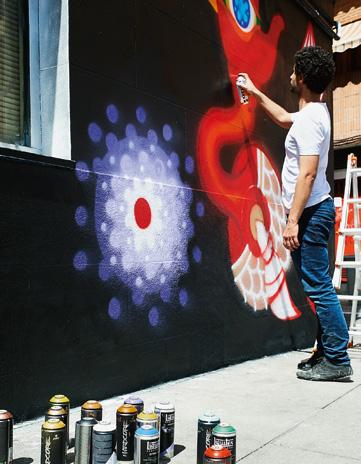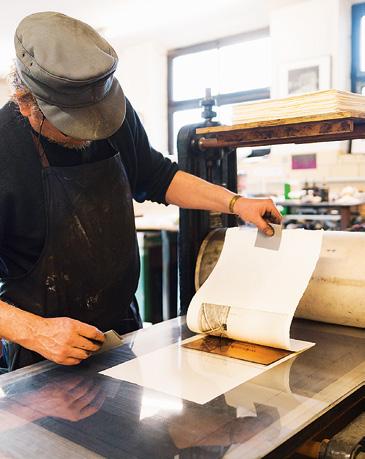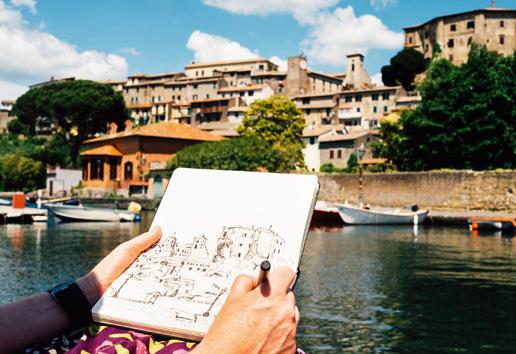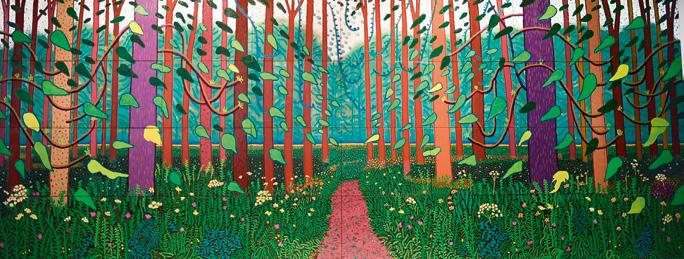
4 minute read
PRODUCING THE WORK OF ART
Focus on English
Trial and error is the process of arriving at a final answer by learning from your mistakes. By attempting to do something (trial) and observing what went wrong (error), an individual can perfect their experiment or skill. The term is common in science, where it is accepted that a question cannot be solved at the first attempt. Similarly, an artist will work by trial and error before they can finish a piece of art, or even find their personal style.
There are many artistic disciplines, but in all of them artists have to answer the question ‘How do I do it?’ Regardless of the motivation or eagerness to create, they have to choose materials and techniques and learn the processes that allow the work to be carried out. Artists organise themselves based on their personality and the work they do. Some workshops are spaces that are full of objects, with chaos and entropy among cans, brushes and other tools. There are other workshops where everything is clean and tidy, and everything is in its place. They are places full of peculiar smells and objects. They are designed for creative work, experimentation, learning by trial and error* and to put different possibilities of expression to the test.
Understand, think and apply...
Reflect and respond
1 a) Round table. How do you think Velázquez started painting, or Rodin carved his first sculpture from marble? How do you think Baryshnikov started dancing? b) Have you ever visited an artist’s studio? What was it like? c) What artistic techniques of expression do you know? What materials have you used for your artistic projects?

The properties of materials
The traits of a specific material (large or small, soft or rough, brittle or strong, etc.) determine its suitability for making a certain object as well as the tools to be used. What would be the most appropriate materials when making a sculpture for a city roundabout, a ninot for the Fallas or a carnival costume? In groups, suggest proposals and find the best solution.

2.1 Materials and supports: possibilities of expression
Artists use various techniques and materials. These can be natural (stone, wood, clay) or synthetic (polystyrene, latex, etc.). Artists have to use sophisticated tools to work with some materials, whilst others which are more traditional, such as fabric, esparto, or even metal do not require the use of these tools.

In some cases, a support, such as paper, cardboard, a canvas or wood is also needed. All this entails a specific vocabulary that an artist must know.


Understand, think and apply...
Make a dictionary of artistic terms
2 To describe certain processes or techniques, you must express yourself with the right words; using specific vocabulary. In groups, create an illustrated dictionary of artistic terms that includes concepts, techniques, materials and tools.
Experiment with alternative supports
3 Did you know that there are artists who use everyday objects as supports? Gilbert Legrand, an artist whose hallmarks are humour and irony, transforms everyday objects.
Choose a household object, transform it and change its meaning.

Examples of different artistic pieces with volume:

2.2 Types of techniques: flat and with volume
We are used to working on a plane, but most things are volumetric. Artists can draw figuratively or abstractly on different supports: paper, a canvas, cardboard, boards, wood, a wall, etc. They apply colour with different materials and techniques: graphite or charcoal, pencils or wax crayons, oil paint, acrylic paint, spray paint, etc.
To build volumetric shapes, artists use techniques such as modelling with flexible materials, carving wood or stone, or metal casting. They also use new materials, such as latex or polystyrene.


Understand, think and apply...
Make a field notebook
4 Provocative questions. A field notebook is an artist’s primary support. It arises from the need to create when out on the street or on a trip. Artists use them to take notes and record what they see and think, capturing the bustle of the city or nature. Get a small notebook and draw in it for seven days. Then show it to your class and talk about the stories behind the drawings.

Build volume with new materials
5 Did you know that you can build large volume works using cork or even just paper? In doing so, you could imitate the pop-up cards of Peter Dahmen (Germany, 1967) or the sculptures of Li Hongbo (China, 1974) which are made from laminates. Use paper mache. Model the paste or apply it to a mould. You can also build in volume with assembled flat pieces.

2.3 Beyond the object: conceptual art, action art and digital art


Art is a reflection of an era. In conceptual art, the result or final product is no longer important. The idea is paramount. The same concept applies to action art and to any performance, as they have a certain duration. In the era of new technology, digital art arises when artists substitute their usual materials with computers, tablets and mobile phones to create multidimensional works. Comic illustrators, video game creators, graphic designers, painters and even sculptors use new technology.
Did you know that David Hockney’s most recent work exhibited at the Royal Academy is not made with brushes but with a tablet?

Find information and discuss with your classmates how new technology has changed the art world and how professional opportunities in the art field have multiplied.
Understand, think and apply...
Paint with the sunlight
6 Did you know that you can use the Sun to make artistic compositions thanks to the fact that solar radiation discolours objects? Start by organising a composition with leaves, stoppers or any other object, and place them on a piece of dark-coloured cardboard. Leave it exposed to the sunlight for a few hours. Then remove the objects. You will see that the silhouettes have been stamped on the cardboard.










